AMD Kaveri Review: A8-7600 and A10-7850K Tested
by Ian Cutress & Rahul Garg on January 14, 2014 8:00 AM ESTDrawing Performance Conclusions
As I progressed through the testing for this review, I became aware of trends in two things: absolute performance, in terms of numbers, and generational improvements across platforms. With AMD moving the Bulldozer based architectures from Piledriver in Trinity and Richland to Steamroller in Kaveri, the base CPU design has had a relatively long run in order to be optimized to the limitations on the CPU side. Obviously AMD has also had a chance to change the lithography node in there as well, and as such has optimized for design rather than performance. This matters a great deal when we look at the power banding (45W, 65W, 95W) and performance in each segment.
In order to display just how much Kaveri has grown in relation to the previous generations, I processed our mountain of data to show graphs where percentage gain against the older generations really does matter. As mentioned previously in this review, it all depends on whether the software can take advantage of the new features afforded by the architecture. In this review we have spent a lot of time discussing advantages for Kaveri in terms of compute (HSA, hUMA, hQ) and gaming (Mantle, TrueAudio), but some of these are still a little way off for software integration. So what does that translate to if you are looking for an APU today – does Kaveri still expand its wings with the integration of the GCN architecture, or does it lag behind due to the lithography node no longer being optimized for frequency. The proof is in the results.
IGP Gaming, 1280x1024
For the 100W APUs at 1280x1024, there is almost no movement between the Richland and the Kaveri APUs, except for Company of Heroes which would seem to leverage the extra SPs more than the MHz available.
45W APUs are clearly in vogue at 1280x1024, each of them providing a good bump over Richland.
IGP Gaming, 1680x1050
1680x1050 sees more benefit for the 100W APUs, but the 45W APUs still show big leaps.
IGP Gaming, 1920x1080
At 1080p the effects are more pronounced all around.
CPU Timed Benchmarks
Unfortunately the CPU timed benchmarks at 100W are bit over the place. Here we are dealing with an IPC gain but MHz deficit, and each benchmark has a different way of dealing with it. For Agisoft, MHz wins, but for Xilisoft, the Kaveri improvements work out well for the system.
At 45W the situation is a lot more clearer, and the newer APUs have the advantage, especially in Adobe After Effects.
CPU Score Benchmarks
45W still makes the biggest jump when it comes to score based CPU benchmarks.
IGP Synthetics
I never like putting much thought into the synthetic results – here both the 100W and the 45W range are showing good improvements all around. 3DMark 06 has the most trouble getting improvements as it relies more on the grunt, rather than the features that Kaveri affords.
IGP Compute
Off the bat we can see just how much of a difference the Kaveri GPU Compute can make over previous APUs. This is still without hUMA fully being in effect while we wait for a proper driver and software stack to become available.
Up to a +222% boost from Kaveri is amazing for a 45W part.
AMD vs Intel
For a little tete-a-tete, putting the 65W Iris Pro up against the 65W Kaveri seems like a good idea. To add to the mix, due to the extreme price difference of Iris Pro in this equation, we also add the 95 W Kaveri for comparison.
It is interesting to note that at the lower resolutions the Iris Pro wins on most benchmarks, but when the resolution and complexity is turned up, especially in Sleeping Dogs, the Kaveri APUs are in the lead.


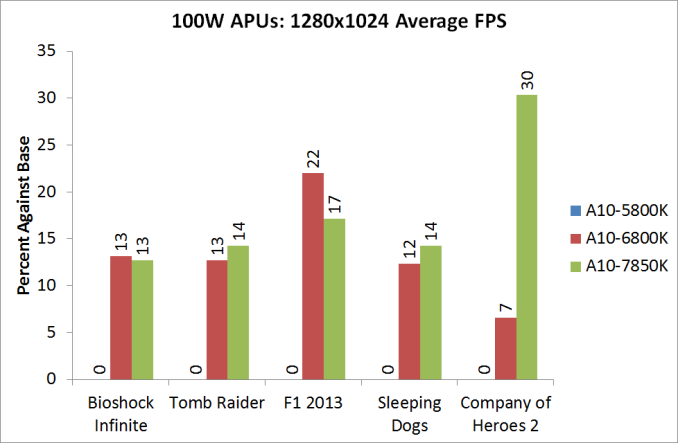
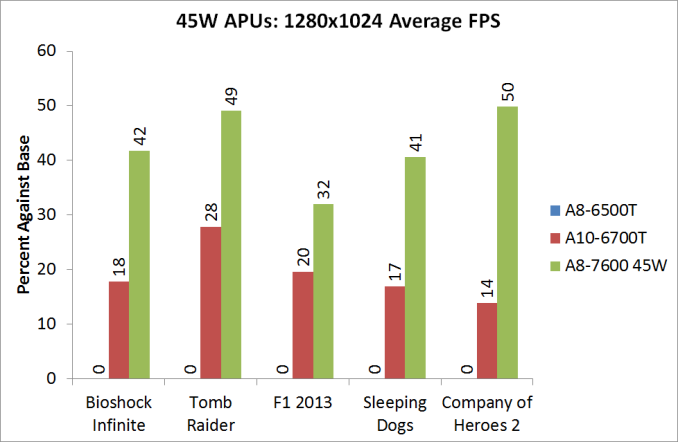
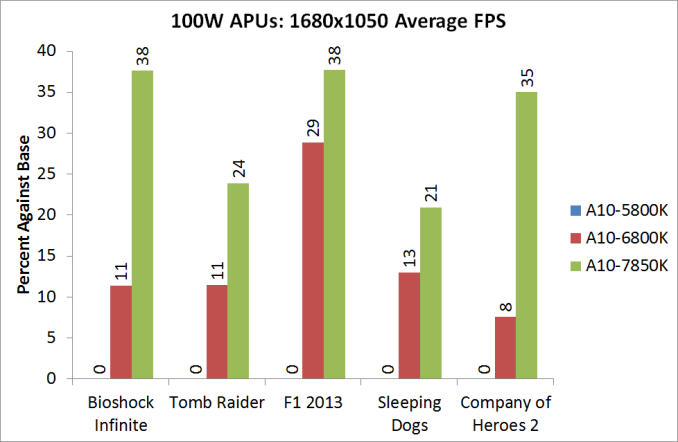
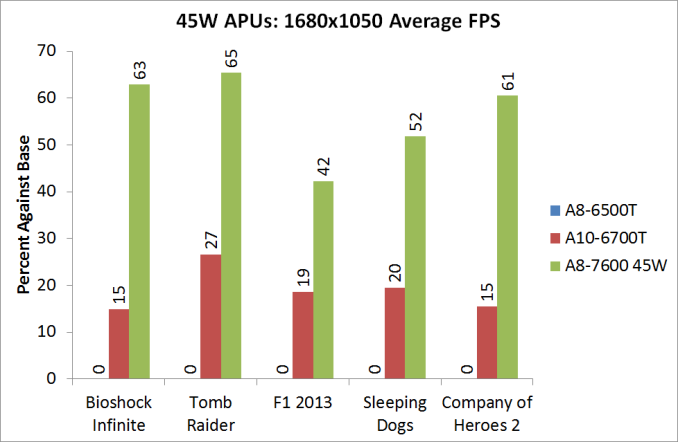
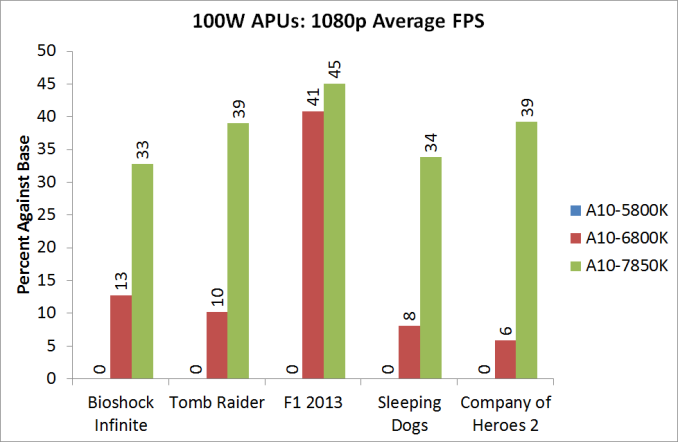

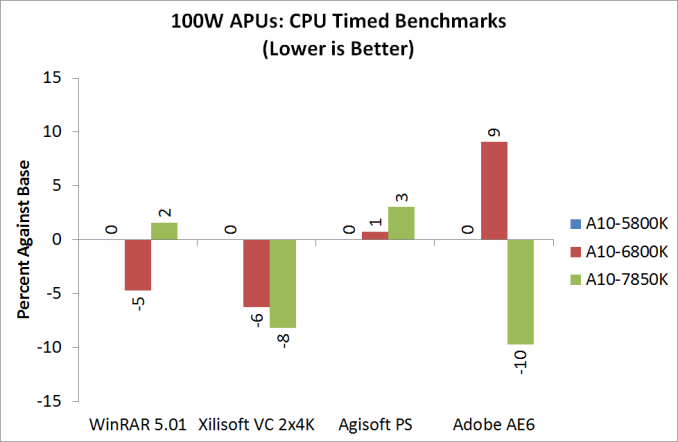
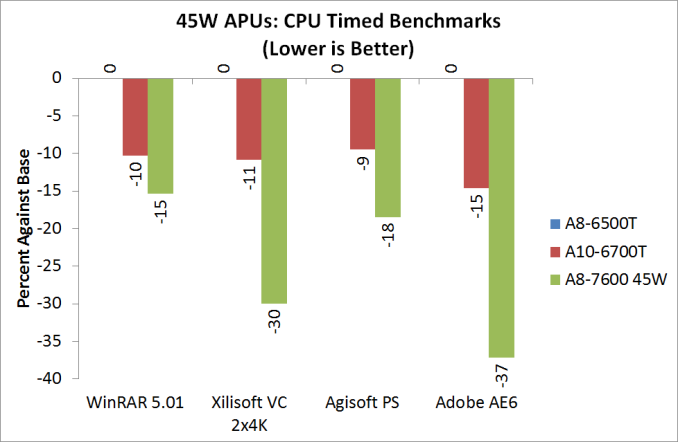

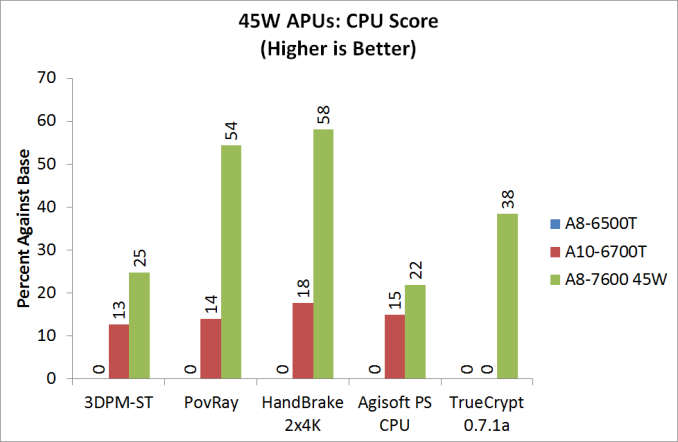
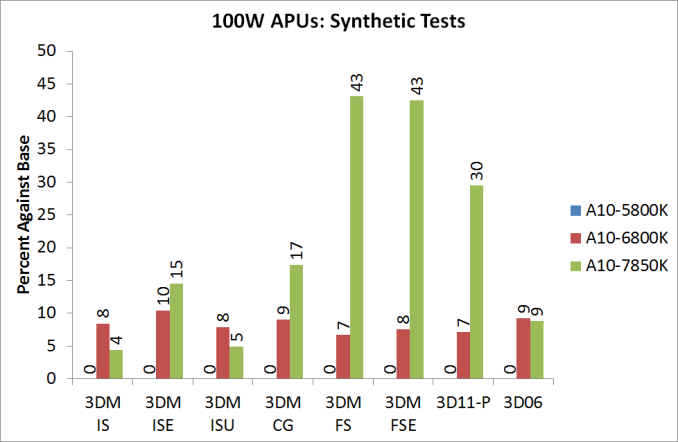
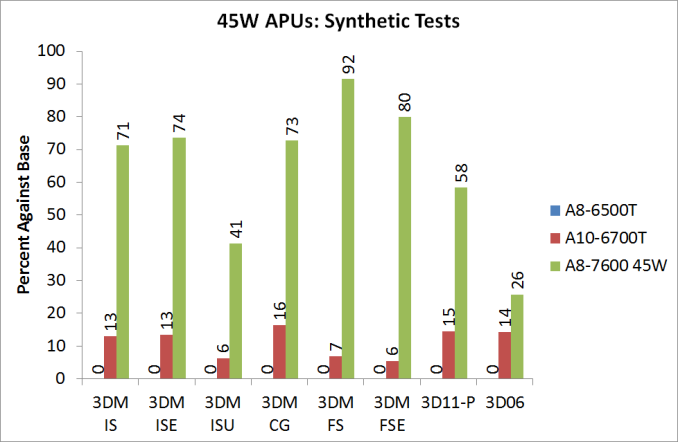
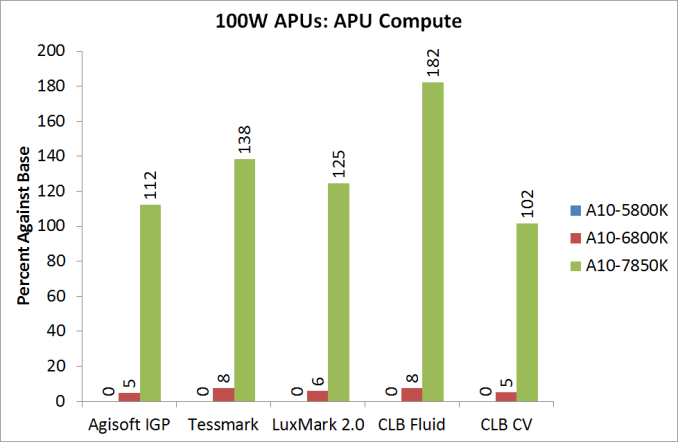

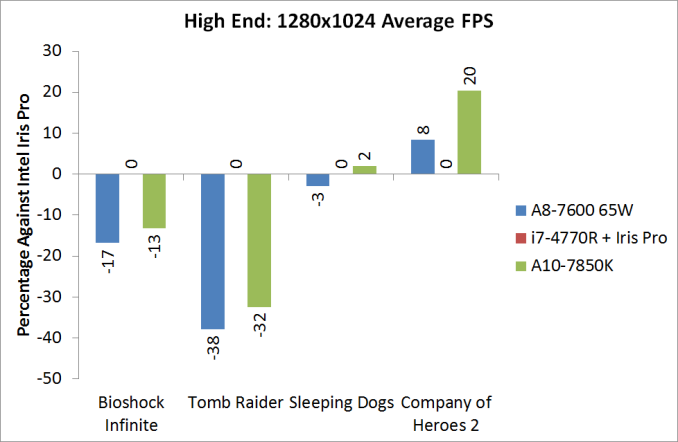
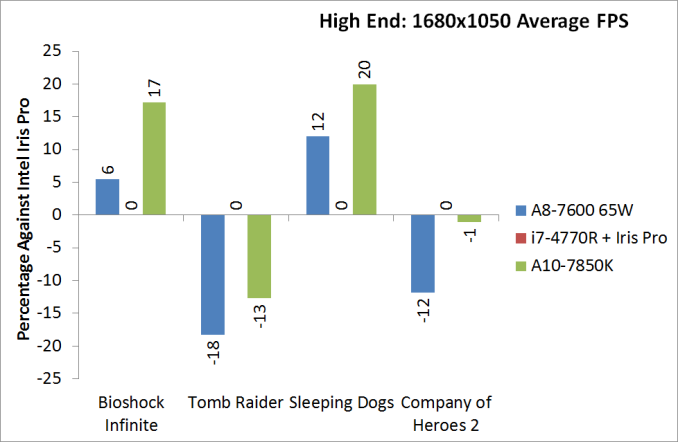
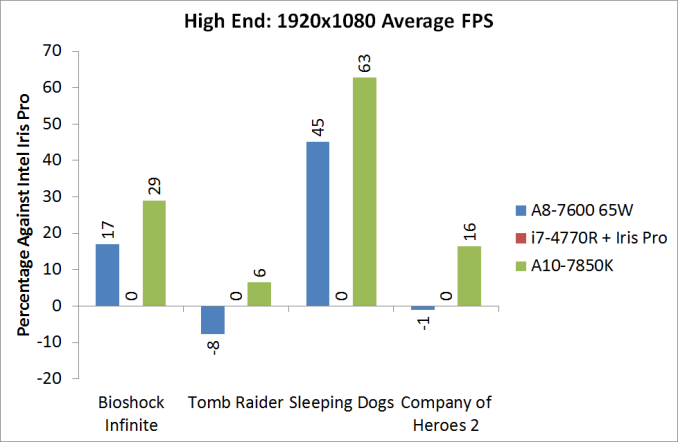








380 Comments
View All Comments
HanzNFranzen - Saturday, January 18, 2014 - link
Yea, 90% of people use Battlefield 4 90% of their time on the PC... You missed the question.keveazy - Saturday, January 18, 2014 - link
Doesn't matter.If you buy a PC, it's better to make sure it's solid and ready to handle applications that require strong physical cpu performance unless your still living the 90s dude.
My point is, AMD's highest end kaveri 7850k chip today is priced at the same range as Intel's low end i5 cpus. From here, you take your pic. If you wanna have a system that has worse graphics than ps4, go AMD.
kmi187 - Sunday, January 19, 2014 - link
If you've actually lived in the 90's you would know that cpu power was a lot more important back then than it is now. You didn't have hardware (gpu) acceleration for video and all that jazz to put less stress on the cpu.Also you do realize the PS4 runs on AMD hardware right?
medi02 - Tuesday, January 28, 2014 - link
What on earth are you talking about? What is a "solid PC"? One that fails at games?cryptik - Monday, March 30, 2015 - link
Today (30 Mar 2015) the AMD A8-7600 is the same price ($99) as the Intel Pentium G3460. The "lowest end" i5 CPU is $189. You're simply a liar who has no idea what he's talking about.vAngz - Sunday, January 26, 2014 - link
I believe you and others are missing the point. Can you play Battlefield 4 on medium settings @ 1080p using only the i5 4430, without using a discrete graphics card, and it still be playable above 30fps?Even though the chips are the same price (at most places), you can actually play BF4 using only the A10 7850K, which is not possible with the i5 4430. I bring this up mainly because you brought up BF4. When, rather if, Mantle is ever activated on BF4, things will change and we will see even better performance on the A10-7850K and later gen AMD APUs.
So, yes, you can get better performance out of the i5 4430, but you will need to spend more money on a discrete graphics card to use it for gaming, such as for BF4. I believe this what sets the AMD APUs apart from Intel offerings at the moment. We need to compare apples to apples.
I could be wrong, but I haven't seen anywhere in my research where anyone is getting that kind of performance out of i5 4430 without a discrete graphics card added into the mix. If you have a link on such info please share it with us. Thanks.
keveazy - Friday, February 7, 2014 - link
Your not getting it either. My mistake in my previous post is I didn't mention Battlefield 4 Multiplayer.That's where the APU will fail. It will fail in both the Cpu performance and Gpu performance. The APU is still the better choice at light gaming.
theduckofdeath - Wednesday, January 15, 2014 - link
I think he's referencing that processor simply because it's a pretty powerful, fairly low-priced processor for all of those who can live without all of those over-clocker tweaks...just4U - Tuesday, January 14, 2014 - link
You talk about 2500K performance and yet the majority of people I come across are not even working with that. The vast majority are still in the C2D/8800 like performance arena. What would be nice to see from some of these review sites in their performance analysis is if stuff like this makes sense to finally bite the bullet and get rid of the old dog..just4U - Tuesday, January 14, 2014 - link
Ian .. that's something I think you should look at btw.. we do get a fair number of lurkers /w some posting up questions like that about how it compares to the old warhorses their on. Hell even for those of us with old parts kicking around it's something to consider. Do we scrounge up some cheap ddr2 psu.. hand me down hard drives and pair it up for that box in front of the television or do we say no.. this makes far more sense and it's new.